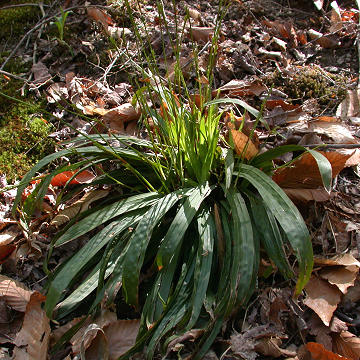

Carex plantaginea - (image 1 of 6)
Taxonomy
Family: Cyperaceae
Section Careyanae
Habitat
Rich mesic woodlands, often under maple and beech.
Associates
Distribution
New Brunswick and southern Quebec west to MN, south to IN, KY, NJ, MD, and in mountains to northern GA.
Morphology
Tufted perennial to 60 cm; fertile stems triangular, reddish-purple at the base; basal sheaths purplish; leaves glabrous, over 12 mm wide; those of the sterile shoots elongate, often surpassing the fertile stems, margin roughened; leaves of fertile stems bladeless or nearly so, reduced to purplish sheaths; terminal spike staminate, 1-2 cm long, purplish, with a long peduncle; pistillate spikes two to four, 1-3 cm, scattered, the lowermost on a short basal peduncle to 2 cm; perigynia crowded and overlapping, 2-ribbed, with many fine nerves, sharply trigonous, outline elliptic, constricted to a short, oblique beak; achenes trigonous.
Notes
Fruiting April to June
Wetland indicator: NA
Most sedges are difficult to identify without examining the perigynia, but this woodland sedge is quite distinct. Only a few sedges have leaves this broad and this is the only one that is deep green without a waxy appearance to the leaves. The leaves also tend to have a crinkly appearance which can help distinguish it from C. careyana. Another common name, seersucker sedge, is a reference to the similarity of the leaves to the puckered surface of seersucker fabric.
References
Gleason, Henry A. and A. Cronquist. 1991. Manual of Vascular Plants of
Northeastern United States and Adjacent Canada. Second Ed.
The New York Botanical Garden. Bronx, NY
Swink, F. and G. Wilhelm. 1994. Plants of the Chicago Region.
Indiana Academy of Science. The Morton Arboretum. Lisle, Illinois.
USDA, NRCS. 2002. The PLANTS Database, Version 3.5 (http://plants.usda.gov).
National Plant Data Center, Baton Rouge, LA 70874-4490 USA.
|
© Michael Hough 2004 |